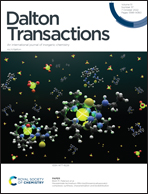Amorphous FeNiCu-MOFs as highly efficient electrocatalysts for the oxygen evolution reaction in an alkaline medium†
Abstract
The preparation of low-cost and high-activity oxygen evolution reaction (OER) catalysts is a technical bottleneck in the field of electrolysis of water to produce hydrogen. Amorphous metal–organic frameworks (MOFs) with low-cost transition metals have attracted increasing attention in the catalytic field, yet metal atoms that are the main active sites are still ambiguous. Here, we synthesized a series of amorphous ternary Fex(NiCu)3−x-MOFs via an ultrasonic method. The optimal amorphous FeNiCu-MOF is found to be able to supply a current density of 10 mA cm−2 merely at a low overpotential of 260 mV with a small Tafel slope of 61 mV dec−1 and exhibits high durability over 24 h. Moreover, density functional theory (DFT) calculations show that the Fe atoms are the main active sites for the OER in the FeNiCu-MOF. This work shows that amorphous ternary MOFs have great potential for application in OER electrocatalysts due to the multiple synergistic effects and amorphous MOF structures.



 Please wait while we load your content...
Please wait while we load your content...